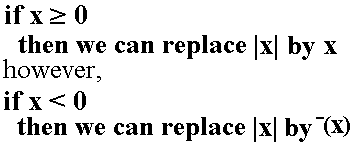
The usual definition of absolute value looks like


| Problem 1 | Solution |
| Find: | 7 | |
Since 7 we replace | 7 | by 7 therefore, the answer is 7. |
| Problem 2 | Solution |
| Find: | – 5 | |
Since – 5 we replace | – 5 | by – ( – 5 ) but, the value of – ( – 5 ) is 5 therefore, the answer is 5. |
| Problem 3 | Solution | ||||
| Find: | x | = 12 |
We do not know if x is negative, or non-negative. We need to know this if we are going to use our definition. We will break the problem into two cases, one where x is negative, and one where x is non-negative.
|
| Problem 4 | Solution | ||||
| Find: | x | = – 7 |
We do not know if x is negative, or non-negative. We need to know this if we are going to use our definition. We will break the problem into two cases, one where x is negative, and one where x is non-negative.
|
| Problem 5 | Solution | ||||
| Find: | x + 8 | = 12 |
We do not know if x + 8 is negative, or non-negative. We need to know this if we are going to use our definition. We will break the problem into two cases, one where x + 8 is negative, and one where x + 8 is non-negative.
|
| Problem 6 | Solution | ||||
| Find: | x + 13 | = 6 |
We do not know if x + 13 is negative, or non-negative. We need to know this if we are going to use our definition. We will break the problem into two cases, one where x + 13 is negative, and one where x + 13 is non-negative.
|
| Problem 7 | Solution | ||||
| Find: | x – 9 | = 4 |
We do not know if x – 9 is negative, or non-negative. We need to know this if we are going to use our definition. We will break the problem into two cases, one where x – 9 is negative, and one where x – 9 is non-negative.
|
| Problem 8 | Solution | ||||
| Find: | 3x + 5 | = 28 |
We do not know if 3x + 5 is negative, or non-negative. We need to know this if we are going to use our definition. We will break the problem into two cases, one where 3x + 5 is negative, and one where 3x + 5 is non-negative.
|
| Problem 9 | Solution | ||||
| Find: | 4x – 9 | = 115 |
We do not know if 4x – 9 is negative, or non-negative. We need to know this if we are going to use our definition. We will break the problem into two cases, one where 4x – 9 is negative, and one where 4x – 9 is non-negative.
|
| Problem 10 | Solution | ||||
| Find: | 7 – 5x | = 33 |
We do not know if 7 – 5x is negative, or non-negative. We need to know this if we are going to use our definition. We will break the problem into two cases, one where 7 – 5x is negative, and one where 7 – 5x is non-negative.
|
| Problem 11 | Solution | ||||
| Find: | x | |
We do not know if x is negative, or non-negative. We need to know this if we are going to use our definition. We will break the problem into two cases, one where x is negative, and one where x is non-negative.
|
| Problem 12 | Solution | ||||
| Find: | x | |
We do not know if x is negative, or non-negative. We need to know this if we are going to use our definition. We will break the problem into two cases, one where x is negative, and one where x is non-negative.
|
| Problem 13 | Solution | ||||
| Find: | x + 5| |
We do not know if x + 5 is negative, or non-negative. We need to know this if we are going to use our definition. We will break the problem into two cases, one where x + 5 is negative, and one where x + 5 is non-negative.
|
| Problem 14 | Solution | ||||
| Find: | x + 9 | |
We do not know if x + 9 is negative, or non-negative. We need to know this if we are going to use our definition. We will break the problem into two cases, one where x + 9 is negative, and one where x + 9 is non-negative.
|
| Problem 15 | Solution | ||||
| Find: | 3x – 4| |
We do not know if 3x – 4 is negative, or non-negative. We need to know this if we are going to use our definition. We will break the problem into two cases, one where 3x – 4 is negative, and one where 3x – 4 is non-negative.
|
| Problem 16 | Solution | ||||
| Find: | 4x–13 | |
We do not know if 4x–13 is negative, or non-negative. We need to know this if we are going to use our definition. We will break the problem into two cases, one where 4x–13 is negative, and one where 4x–13 is non-negative.
|
PRECALCULUS: College Algebra and Trigonometry
© 2000 Dennis Bila, James Egan, Roger Palay